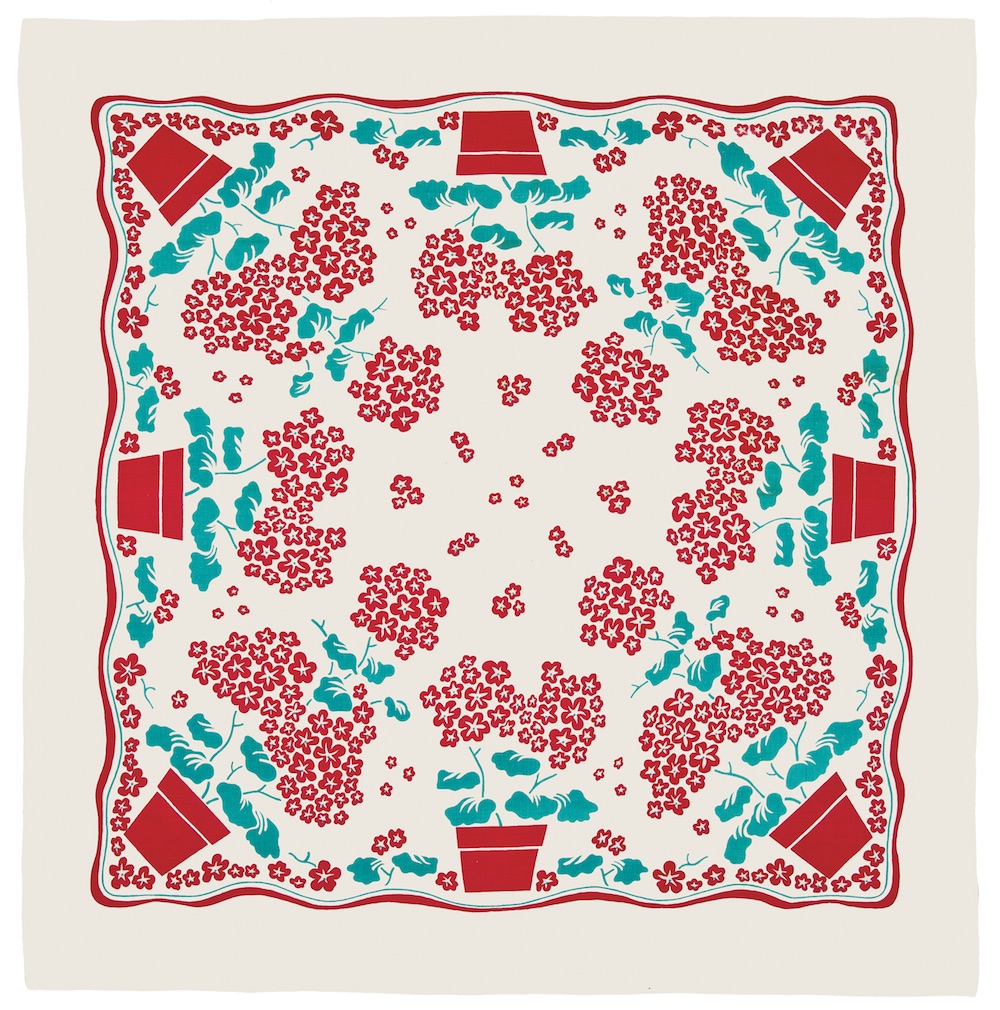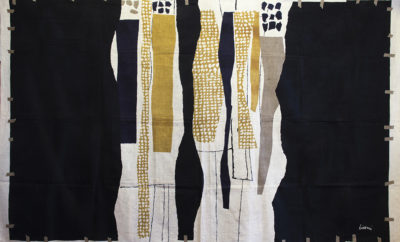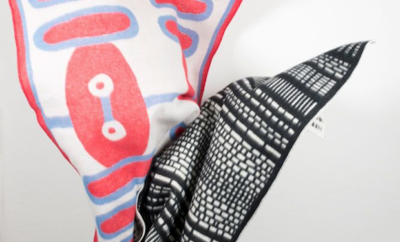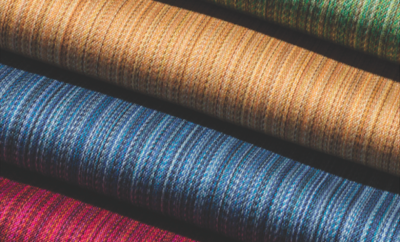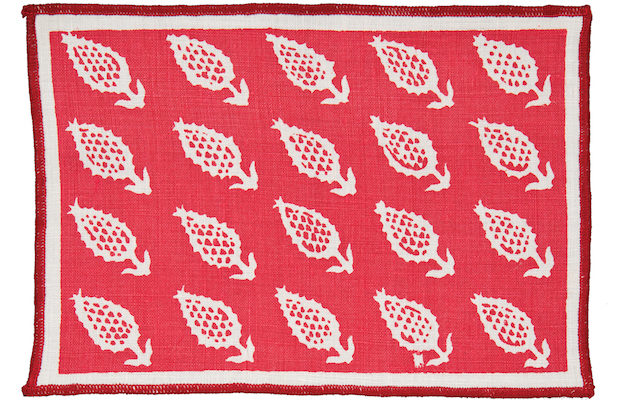
Design
Marguerita Mergentime: Inventing Tablecloths
After her mother, Molly Bayer, died in 2008, Virginia Bayer found a treasure trove of designs, textiles, and scrapbooks that had belonged to her grandmother Marguerita Mergentime. Her curiosity led her to uncover the role Mergentime had played in the decorative arts movement of the 1930s. The newly published book Marguerita Mergentime: American Textiles, Modern Ideas reintroduces the spirited design pioneer and recognizes her importance in that era. The following text has been excerpted and abridged from the original.

Marguerita Mergentime: American Textiles, Modern Ideas
Edited by Donna Ghelerter
Foreword by Madelyn Shaw
Text by Virginia Bayer, Linda Florio, Donna Ghelerter West Madison Press, New York
(www.artbook.com/9780692768273.html)
(145 pages, $39.95)
I GREW UP KNOWING that my grandmother Marguerita Mergentime designed the Jolly Geranium kitchen towel and a fabric for Radio City Music Hall, but, until recently, I knew little else about her career in New York in the 1930s. And now, with this publication, we will all know quite a bit more about the woman who asked, “Are you allergic to meaningless uninspired patterns in printed cloths?” and set about designing table linens.
While individual designers of household items are often anonymous, their work known not by the designer’s name but by that of the manufacturer, there are exceptions, and Marguerita Mergentime was one of them. During her career, she made a name for herself at a time when it was particularly rare for designers of table linens and kitchenwares to obtain consumer recognition. And it was unusual for women to be among the ranks of Mergentime’s impressive male colleagues, such as Donald Deskey, Russel Wright, and
Norman Bel Geddes. Mergentime, finding her niche in printed linens for the table, was well situated amid this ultratalented crowd that concerned itself with shaping the design sensibility of the modern American home.
Marguerita Mergentime: innovative, passionate, courageous, pioneering, and clever; designer of table linens, shower curtains, sheets, towels, bed-spreads, drapery, flatware, and china. But it was for her strikingly new printed table linens that she became best known, making her mark with tablecloths created to enliven the average home with color, humor, and entertainment. Articles and advertisements in numerous newspapers and trade journals promoted her career across the United States. A reporter in 1939 summed it up perfectly: “Informal table linen was pretty unimaginative until Marguerita Mergentime came along with her bright and gay designs which jolted the manufacturers out of their lethargy. ”It has been said that modern design entered the house through the bathroom and kitchen. And so did Mergentime and her novel take on household products. For the bathroom, her shower curtains were decorated with stars, plaids, or oversized monograms; her bath towels, manufactured by Martex in a line called Splendor that remained in production for years, featured asymmetrical stripes. For kitchens and dining rooms, she pioneered the idea of ensembles of china, glass, and linens, as well as sets of placemats and runners.

Lilies in the Air, a sample design for curtains and wall coverings in the ladies’ powder room on the Grand Lounge level of Radio City Music Hall, c. 1932. Michael Fredericks Photo, © Mergentime Family Archives
Even the bedroom was not off-limits to Mergentime’s fresh ideas. Clever and economical at the same time, she created printed sheets where only the fold-over of the top sheet and the pillowcases were patterned with plaids or large polka dots, allowing the buyer to use any white bottom sheet. These received much notice as they were a “brand new idea for sheets” and were featured in Vogue’s “Shop-Hound” column: “We’ve had crepe sheets, and we have had colored sheets, and we have had sheets embroidered with rosebuds; and now we have printed sheets. . . . Marguerita Mergentime thought up this dashing idea.” The sheets, as well as other Mergentime linens, were included as part of the fully furnished displays of the new Moto-home prefabricated houses as they were considered “appropriately modern and mechanical.”
She approached the design of table linens and table decoration from the hostess’s point of view: First, following the modernist precept that form follows function, she designed for their ultimate, functional use—covering a table. But a hostess must also concern herself with her guests’ enjoyment. With that thought, she presaged our post-modern conception of design as dependent on the user for its meaning and value. Called “user interface” today, Mergentime referred to her tablecloths as being both “gustatory and guestatory.”
[In 1941] Marguerita Mergentime’s life was cut short by illness. There were red, white, and blue flower arrangements at the funeral in a fitting tribute to her use of America’s past artistic heritage in her work: “Her intense enthusiasm for using American design in a modern idiom and her outstanding endeavor in that direction will long be remembered, and should prove a source of inspiration to others who are forging ahead at a time when enthusiasm and originality in creating American designs are desperately needed.” Tributes praising her as a design trailblazer appeared in trade journals, as well as in the New York Times and the New York Post. But perhaps none attested to her impact as fully as Alfred Auerbach’s reflection in 1962, twenty years after her death: “Some day perhaps the Museum of Modern Art will stage a retrospective show of the pioneers in modern design in America and proper credit will be given not only to [Edward] Wormley but also to Gilbert Rohde, Paul Frankl, Eugene Schoen, Vally Wieselthier, Marguerite [sic] Mergentime, Norman Bel Geddes, Wolfgang Hoffmann. . . all names that have passed off the scene but all valiant fighters in their time.”


